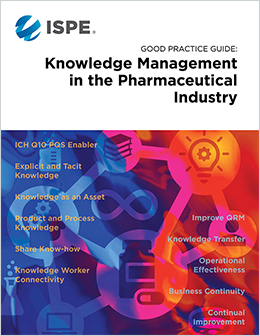Good Practice Guide: Knowledge Management in Pharmaceutical Industry

Published: May 2021
Pages: 160
ICH Q10 outlines three objectives: achieve product realization, establish and maintain a state of control, and facilitate continual improvement. Embracing these objectives can be best achieved using the dual enablers, Knowledge Management (KM) and Quality Risk Management (QRM). The first reference to KM in the field of pharmaceutical quality was in ICH Q8 in 2005 as a tool used with QRM for a more systematic Quality by Design (QbD) approach to development throughout the product lifecycle. Three years later, ICH Q10 identified KM and QRM as the enablers of an effective Pharmaceutical Quality System (PQS).
Since then, the pharmaceutical industry has made significant progress in adopting QRM into systems and processes. However, the industry has been slow in implementing KM, thus missing the quality, operational, and employee engagement advantages KM practices have to offer. The ISPE Good Practice Guide: Knowledge Management in the Pharmaceutical Industry discusses how KM can enable a more effective PQS. The first such guidance in the pharmaceutical industry, the Guide promotes uniting KM with QRM to enable better risk-based decisions, and shows how KM can enhance nearly every element of the PQS across the product lifecycle. In addition, there are substantial and compelling benefits of effective KM beyond the quality system, such as improved business performance by increasing efficiency, building more robust processes, facilitating continual improvement, and creating an engaged knowledge workforce.
In other industries, KM is widely recognized as a stand-alone discipline. To help the pharmaceutical industry progress, this Guide presents the importance and associated benefits of effective KM, and includes definitions, principles, and supporting concepts. The Guide provides numerous references to other industries that have successfully adopted and maintained KM programs as part of their routine business processes. The Guide also contains pharmaceutical industry-specific case studies that show why the KM initiative was started, how obstacles were overcome, and how the methods and tools implemented made the KM program sustainable.
The ISPE Good Practice Guide: Knowledge Management in the Pharmaceutical Industry places an emphasis on tacit knowledge – often referred to as know-how and know-why. A systematic KM program that manages tacit knowledge is a powerful tool to help maximize knowledge awareness and minimize knowledge loss that can threaten business continuity. This Guide aims to highlight the importance and impact of tacit knowledge, and where appropriate, provide KM methods and tools to better recognize, capture, transfer, and apply tacit knowledge.
The Getting Started section of the Guide presents clear and pragmatic activities to foster the first steps for a KM effort, including advice to start small and ways to measure progress.
Data volume is also covered in the ISPE Good Practice Guide: Knowledge Management in the Pharmaceutical Industry. The amount of data, information, and knowledge available today is huge and expected to grow exponentially. Without technology, human beings cannot manage this increasing volume of data along with its variety and complexity. The Guide explores the potential of digitalization and Pharma 4.0™ enabling technologies in support of the evolution of data, information, and KM as part of a solution inclusive of people, business processes, and governance.
Some of the many methods and tools presented and discussed in this Guide include:
- Knowledge Mapping – identifies critical knowledge in a business process or organization and surfaces gaps in knowledge quality or availability
- Maturity Assessment – measures an organization’s KM maturity and identifies opportunities for improvement
- Expertise Location – provides rapid connection to an expert, saving time addressing the issue at hand
Other key takeaways include:
- Emphasis on Technology Transfer, including references to the ISPE Good Practice Guide: Technology Transfer
- Linkages to the ISPE PQLI Guides
- The relationship between KM and QRM
- How the Guide relates to the ISO standard for KM, ISO 30401
- The importance of Organizational Change Management
Establishing an effective KM strategy requires a change from current business practices and ways of working for most organizations but implementing a culture embracing KM is an advantage to all aspects of the pharmaceutical industry. The ISPE Good Practice Guide: Knowledge Management in the Pharmaceutical Industry discusses organizational change management to facilitate colleague engagement and ensure people understand the reasons to focus on KM and successfully adopt more effective ways of working.
The practical principles, methods, and tools provided in this Guide will help organizations improve their capabilities in managing knowledge and using that knowledge to support an effective PQS resulting in improved PQS outcomes (e.g., better risk-based decision making) and operational performance, among other benefits.
Exploring the Risk-Knowledge Infinity Cycle (RKI Cycle) across the Product Lifecycle
Quality Risk Management (QRM) and Knowledge Management (KM) are the enablers of an effective Pharmaceutical Quality System. But are companies integrating these disciplines well? A survey conducted in February 2021 suggests not. The Risk-Knowledge Infinity Cycle (RKI Cycle) framework, which can be applied across the entire product lifecycle, has been proposed, to better integrate QRM and KM. The survey results also suggest that implementing a framework such as the RKI Cycle to better unite QRM and KM has the potential to enable a variety of significant benefits including better risk-based decisions, improved control strategies, and more.
Providing supplemental information to the ISPE Good Practice Guide: Knowledge Management in the Pharmaceutical Industry, this paper, “Exploring the Risk-Knowledge Infinity Cycle (RKI Cycle) across the Product Lifecycle” takes a deeper look into the inverse relationship between risk and knowledge application. Increased knowledge provides improved understanding, which leads to decreased uncertainty. And when knowledge is applied appropriately, there is lower risk. The paper presents the RKI Cycle as a cohesion of QRM and KM by defining a stepwise integrated and cyclical process, where an organization continually seeks to maximize knowledge and minimize risk. Short case studies in the Commercial Manufacturing and Technology Transfer lifecycle phases demonstrate the practical application of the RKI Cycle and its associated concepts.